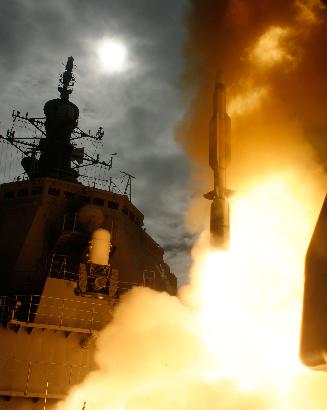Oh yeah, Watch this!!
Sometime in the next 11 days, a Navy cruiser is going to aim a missile just above the atmosphere, and try to take out a malfunctioning spy satellite before it crashes to Earth -- and maybe releases a toxic gas in the process.

Defense Department officials detailed the shoot down operation, in a briefing with reporters Thursday afternoon.
The 5,000-pound National Reconnaissance Office surveillance satellite was pronounced dead just a few hours after it was inserted into orbit, on Dec. 14, 2006.

This January, the U.S. military realized that the satellite was beginning its descent down into the atmosphere, Deputy National Security Advisor James Jeffrey noted. Ordinarily, this wouldn't be much cause for concern; objects of this size plummet into the Earth's atmosphere all the time. But this satellite contains a full tank -- over 1,000 pounds' worth -- of the rocket propellant hydrazine. And there's a small but real risk that the tank could rupture, releasing a "toxic gas" over a "populated area," causing a "risk to human life."
The chances of "hitting land or a person as a hunk" are low, added Joint Chiefs of Staff Vice Chairman Gen. James Cartwright. "What's different here is the hydrazine."
The plan is to fire a modified SM-3 interceptor at the satellite....
The take down attempt could come as early as three or four days from now. After that, there will be a window of seven to eight days in which a shot will be possible.
"This is the first time we've used a tactical missile to engage a spacecraft," Cartwright said.
1. The intercept will occur at 240 kilometers (130 nautical miles)
2. The mass of the satellite is 2,300 kg (5,000 pounds)
3. The mass of the interceptor is 20 kg. (From CBO)
4. The closing velocity will be 9.8 km/s (22,000 mph), suggesting a virtually head-on collision.
Other pertinent observations. At 240 km, the satellite should be traveling 7.8 km/s; the SM-3 has a burnout velocity of 3 km/s.
SOURCE: Wired,
xxxxxxxxxxxxxxxxxxxxxxxxxxxx
Shooting down a satellite is particularly sensitive because of the controversy surrounding China's anti-satellite test last year, when Beijing shot down one of its defunct weather satellites, drawing immediate criticism from the U.S. and other countries.
There is a more important message here,
Iran, get it into orbit and USA can still shoot it down,
with what USA has on hand now,
from a ship at sea,
any where in the world.
From over the horizon to space to over the horizon.
Gerald

.

Defense Department officials detailed the shoot down operation, in a briefing with reporters Thursday afternoon.
The 5,000-pound National Reconnaissance Office surveillance satellite was pronounced dead just a few hours after it was inserted into orbit, on Dec. 14, 2006.

This January, the U.S. military realized that the satellite was beginning its descent down into the atmosphere, Deputy National Security Advisor James Jeffrey noted. Ordinarily, this wouldn't be much cause for concern; objects of this size plummet into the Earth's atmosphere all the time. But this satellite contains a full tank -- over 1,000 pounds' worth -- of the rocket propellant hydrazine. And there's a small but real risk that the tank could rupture, releasing a "toxic gas" over a "populated area," causing a "risk to human life."
The chances of "hitting land or a person as a hunk" are low, added Joint Chiefs of Staff Vice Chairman Gen. James Cartwright. "What's different here is the hydrazine."
The plan is to fire a modified SM-3 interceptor at the satellite....
The take down attempt could come as early as three or four days from now. After that, there will be a window of seven to eight days in which a shot will be possible.
"This is the first time we've used a tactical missile to engage a spacecraft," Cartwright said.
1. The intercept will occur at 240 kilometers (130 nautical miles)
2. The mass of the satellite is 2,300 kg (5,000 pounds)
3. The mass of the interceptor is 20 kg. (From CBO)
4. The closing velocity will be 9.8 km/s (22,000 mph), suggesting a virtually head-on collision.
Other pertinent observations. At 240 km, the satellite should be traveling 7.8 km/s; the SM-3 has a burnout velocity of 3 km/s.
SOURCE: Wired,
xxxxxxxxxxxxxxxxxxxxxxxxxxxx
Shooting down a satellite is particularly sensitive because of the controversy surrounding China's anti-satellite test last year, when Beijing shot down one of its defunct weather satellites, drawing immediate criticism from the U.S. and other countries.
There is a more important message here,
Iran, get it into orbit and USA can still shoot it down,
with what USA has on hand now,
from a ship at sea,
any where in the world.
From over the horizon to space to over the horizon.
Gerald

.
Labels: shootdown, SM-3, spy satellite



0 Comments:
Post a Comment
Subscribe to Post Comments [Atom]
<< Home